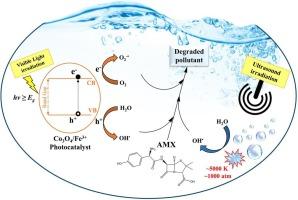评价行星球磨法制备的Fe(III)掺杂氧化钴纳米颗粒降解污染物阿莫西林的声光催化活性
Q1 Environmental Science
Environmental Nanotechnology, Monitoring and Management
Pub Date : 2025-07-30
DOI:10.1016/j.enmm.2025.101091
引用次数: 0
摘要
世界水资源受到人口增长和工业扩张双重力量的威胁。先进的氧化技术,特别是光催化工艺,通过分解有机污染物,为这一问题提供了一个实用而环保的解决方案,提供了一个更清洁、更安全的水生环境。采用球磨法掺杂铁(III)离子,研究了纳米颗粒(NPs)的可见光谱活性。利用透射电镜(TEM)、x射线衍射(XRD)和布鲁诺尔-埃米特-泰勒(BET)等先进技术对合成的NPs进行了表征。实验结果表明,合成的NPs具有一致的介孔结构。研究结果表明,使用Co3O4/Fe3+ NPs时,声催化、光催化和声光催化技术在1小时内可显著降低药物污染物阿莫西林(AMX)的含量,分别降低46.26%、60.34%和83.14%。40.37%的协同效应证明了掺杂NPs的效率。此外,实验数据与伪二阶方程非常吻合,证实了反应符合二阶动力学。清除剂如甲酸、草酸二钠和异丙醇表现出减少作用,分别使降解率降低29.44%、36.62%和74%。此外,在所有四个循环中,降解率的可忽略不计的下降证实了Co3O4/Fe3+ NPs的可重用性和性能。本文章由计算机程序翻译,如有差异,请以英文原文为准。

Evaluating the sonophotocatalytic activity of Fe(III) doped cobalt oxide nanoparticles prepared by planetary ball milling method in the degradation of amoxicillin as a pollutant
The world’s waters threatened by the dual forces of demographic growth and industrial expansion. Advanced oxidation techniques, particularly photocatalytic processes, offer a practical and eco-friendly solution to this problem by decomposing organic contaminants, providing a cleaner and safer aquatic environment. Doping of iron(III) ions through the ball milling method was applied to study the activity of nanoparticles (NPs) in the visible spectrum. Advanced techniques were employed to characterize synthesized NPs, utilizing Transmission Electron Microscopy (TEM), X-ray Diffraction (XRD), and Brunauer-Emmett-Teller (BET). The synthesized NPs exhibit a consistent mesoporous structure, as demonstrated by the experimental findings. Research findings indicate that the application of sonocatalytic, photocatalytic, and sonophotocatalytic techniques significantly reduced amoxicillin (AMX), a pharmaceutical pollutant, levels by 46.26%, 60.34%, and 83.14%, respectively, within the one-hour timeframe when utilizing Co3O4/Fe3+ NPs. The 40.37% synergistic effect demonstrated the doped NPs’ efficiency. Additionally, the experimental data strongly aligns with the pseudo-second-order equation, confirming the reaction’s adherence to second-order kinetics. Scavengers like formic acid, disodium oxalate, and isopropanol demonstrated a reduction impact, slowing down the degradation rate by 29.44%, 36.62%, and 74%, respectively. Furthermore, across all four cycles, the negligible decline in the degradation rate confirmed the Co3O4/Fe3+ NPs’ reusability and performance.
求助全文
通过发布文献求助,成功后即可免费获取论文全文。
去求助
来源期刊

Environmental Nanotechnology, Monitoring and Management
Environmental Science-Water Science and Technology
CiteScore
13.00
自引率
0.00%
发文量
132
审稿时长
48 days
期刊介绍:
Environmental Nanotechnology, Monitoring and Management is a journal devoted to the publication of peer reviewed original research on environmental nanotechnologies, monitoring studies and management for water, soil , waste and human health samples. Critical review articles, short communications and scientific policy briefs are also welcome. The journal will include all environmental matrices except air. Nanomaterials were suggested as efficient cost-effective and environmental friendly alternative to existing treatment materials, from the standpoints of both resource conservation and environmental remediation. The journal aims to receive papers in the field of nanotechnology covering; Developments of new nanosorbents for: •Groundwater, drinking water and wastewater treatment •Remediation of contaminated sites •Assessment of novel nanotechnologies including sustainability and life cycle implications Monitoring and Management papers should cover the fields of: •Novel analytical methods applied to environmental and health samples •Fate and transport of pollutants in the environment •Case studies covering environmental monitoring and public health •Water and soil prevention and legislation •Industrial and hazardous waste- legislation, characterisation, management practices, minimization, treatment and disposal •Environmental management and remediation
 求助内容:
求助内容: 应助结果提醒方式:
应助结果提醒方式:


